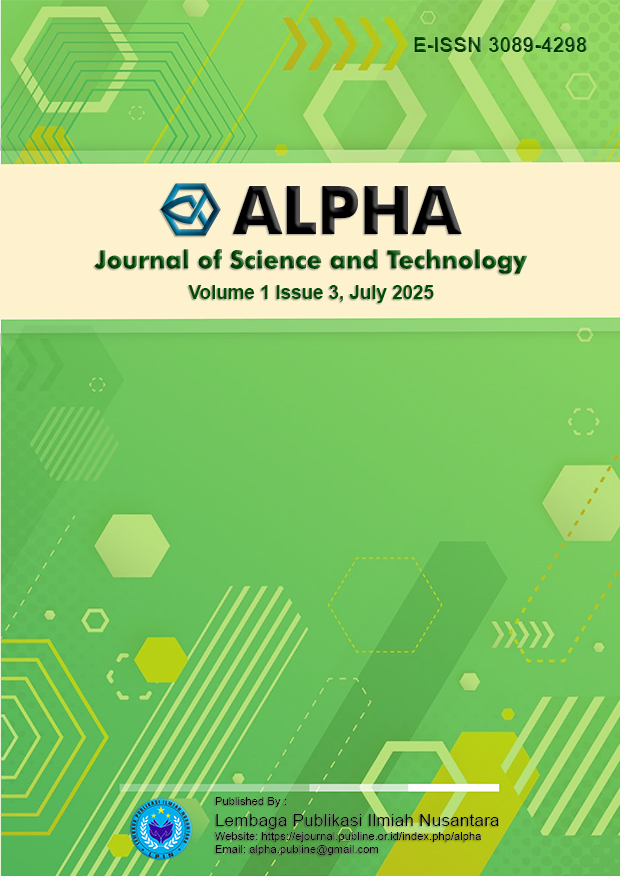Pola Kristalisasi Garam Dalam Kondisi Lingkungan Ekstrem
DOI:
https://doi.org/10.70716/alpha.v1i3.237Keywords:
Salt Crystallization, Extreme Environments, Crystal Morphology, High Temperature, Low HumidityAbstract
Salt crystallization is a fundamental process that is greatly influenced by environmental conditions, including temperature, humidity, pressure, and atmospheric composition. This study aims to analyze salt crystallization patterns occurring under extreme environmental conditions, such as high temperatures, very low humidity, as well as hypersaline and low-temperature environments. The methods used include laboratory experiments with simulated extreme environments using a climate control chamber and microscopic analysis of the shape and structure of the resulting salt crystals. The research findings show that extreme environmental conditions significantly affect the morphology and growth rate of salt crystals. Under high temperatures and low humidity, crystals tend to form complex dendritic structures with higher growth rates. Conversely, at low temperatures and high pressure, crystals tend to form cubic shapes with denser structures and slower growth. Hypersaline environments exhibit unique crystallization patterns, including the formation of irregularly shaped crystals and non-homogeneous surface patterns. These findings are important for further understanding of natural geochemical processes in extreme environments such as salt deserts, hypersaline lakes, or extraterrestrial planets like Mars. In addition, the results can be applied to desalination technology and more efficient industrial salt production.
Downloads
References
Amin, A. A., Salamah, L. N., Al Zamzami, I. M., Susanti, Y. A. D., Yanuar, A. T., & Kurniawan, A. (2024). Aplikasi Tandon-Filter untuk meningkatkan Kualitas dan Kuantitas Garam dalam Teknologi Greenhouse Salt Tunnel di Pantai Selatan dan Utara Jawa Timur. Rekayasa, 17(1), 143-151.
Hendarto, H. (2020). Aplikasi teknologi ulir filter dalam peningkatan mutu garam lokal. Jurnal Inovasi Teknologi Pertanian, 12(2), 102–111.
Irham, M., & Kurniawan, H. (2023). Karakterisasi komunitas bakteri halofilik pada tahapan kristalisasi garam rakyat. Jurnal Biologi Tropis, 10(1), 44–51.
Jumaeri, J., Sari, D. R., & Wahyuni, L. (2016). Pengaruh aktivasi zeolit terhadap peningkatan kualitas garam rakyat. Jurnal Teknologi Lingkungan, 17(3), 172–179.
Redjeki, S., Rachmawati, E., & Fitriyani, S. (2023). Peningkatan mutu garam rakyat melalui pengendapan ion Ca dan Mg. Jurnal Teknologi Industri, 15(1), 33–41.
Rismana, E., & Zainuddin, M. (2017). Uji mutu garam aneka pangan hasil kristalisasi larutan brine. Jurnal Gizi dan Industri Pangan, 3(2), 88–95.
Al Asyrafi, M. W. A., Natalisanto, A. I., & Gunawan, R. (2021). Pembuatan dan Karakterisasi Rochelle Salt Crystal. Progressive Physics Journal, 2(1), 8-18.
Triajie, F. N., & Insafitri, A. (2016). Penggunaan aditif non-kimia untuk peningkatan mutu garam rakyat di Madura. Jurnal Kelautan dan Perikanan, 7(2), 109–118.
Zulfian, R., Aditya, R., & Mustofa, M. (2023). Kristalisasi struvite dari limbah cucian garam industri menggunakan reaktor kolom. Jurnal Rekayasa Proses, 19(1), 58–66.
Downloads
Published
How to Cite
Issue
Section
License
Copyright (c) 2025 Ainiyatul Azizah, Nania Nova Angelina

This work is licensed under a Creative Commons Attribution-ShareAlike 4.0 International License.











